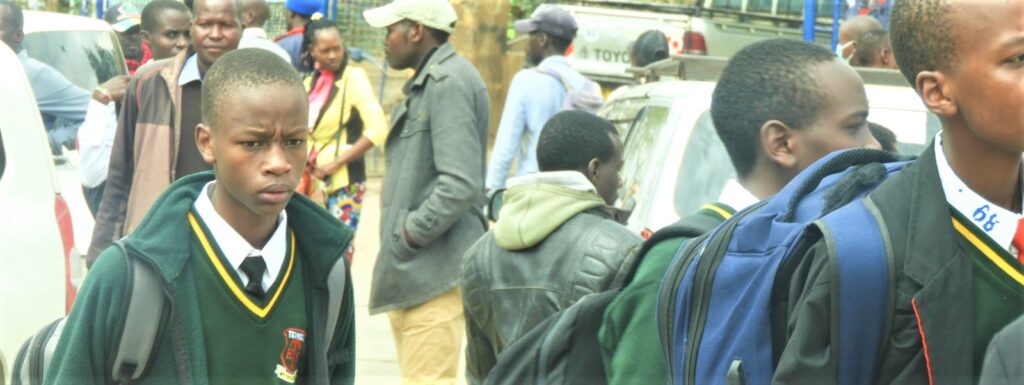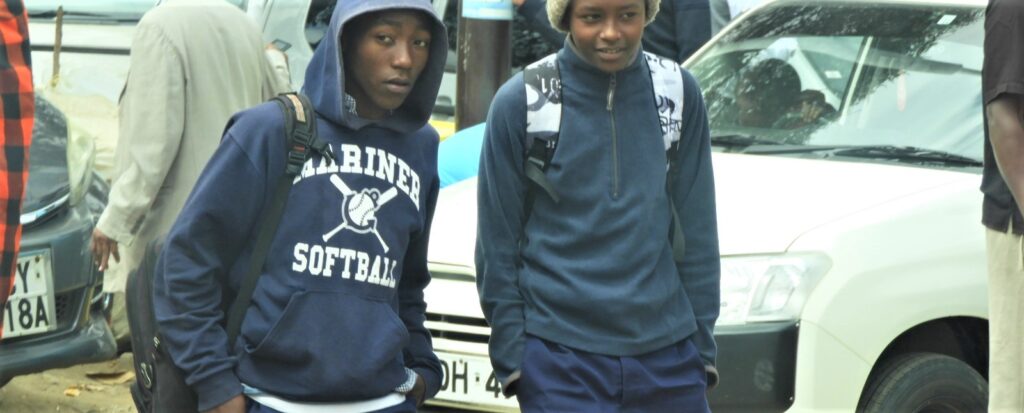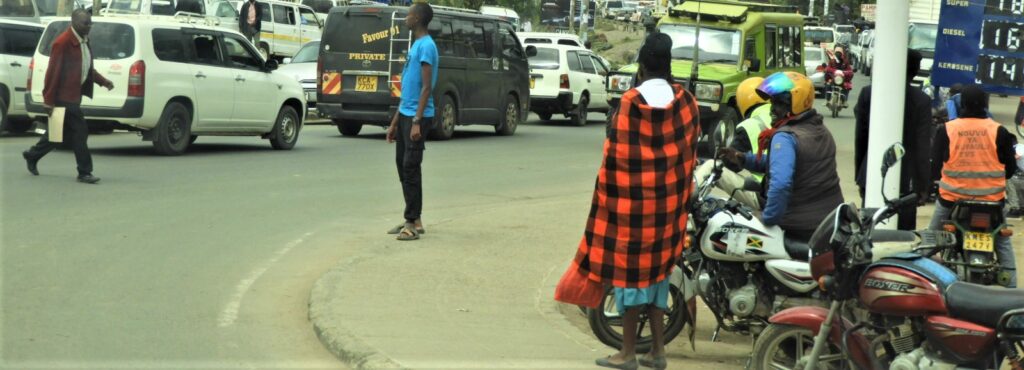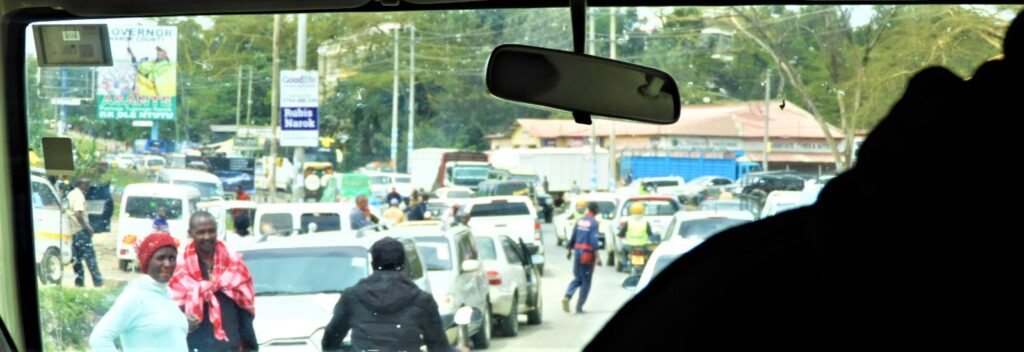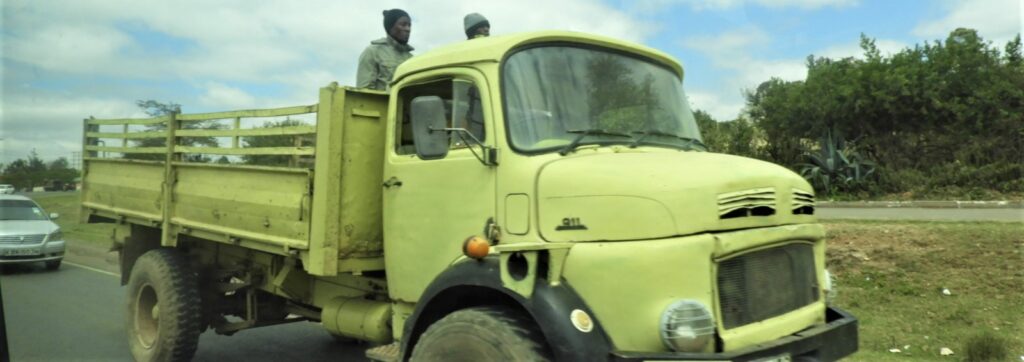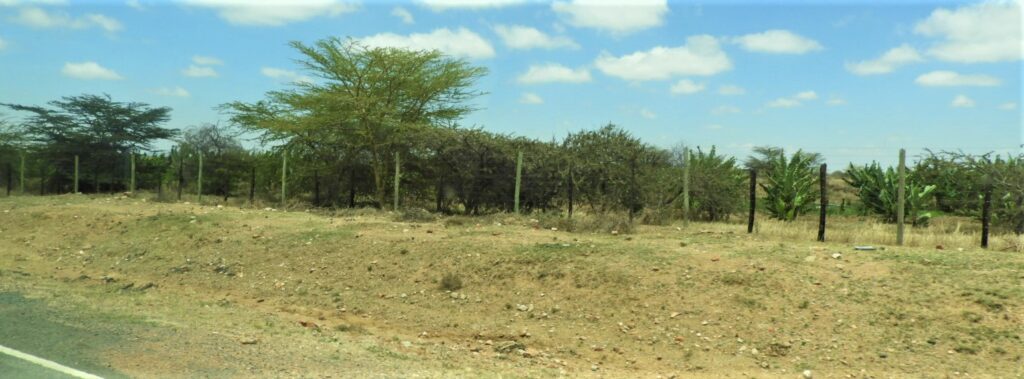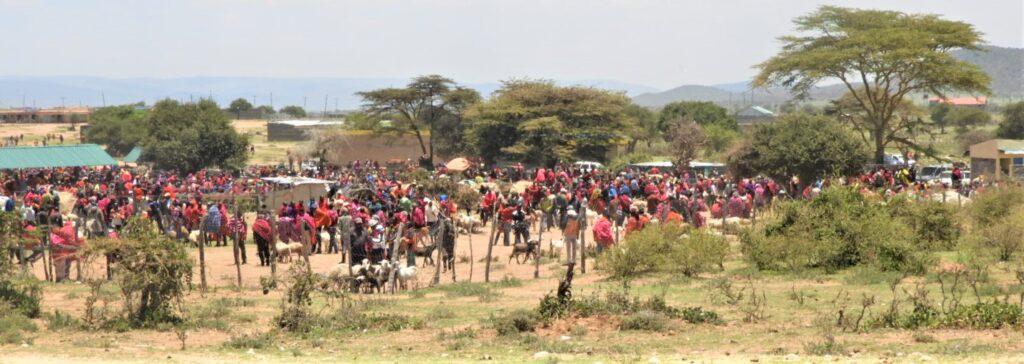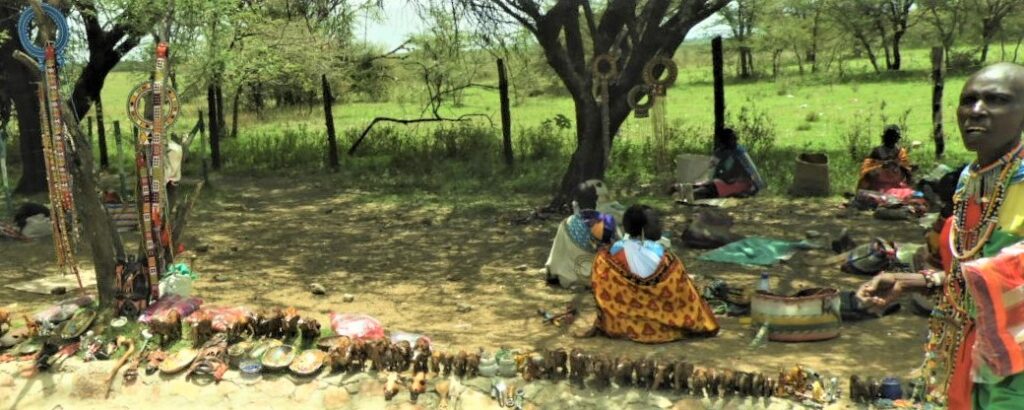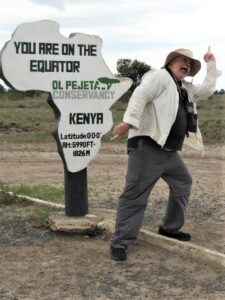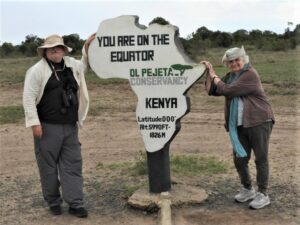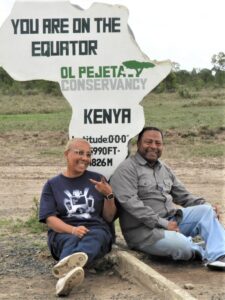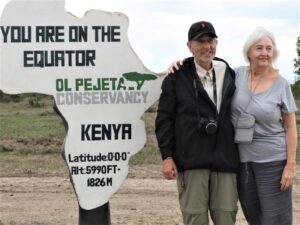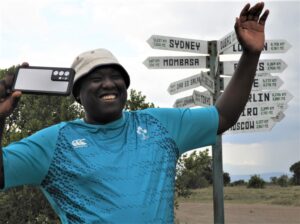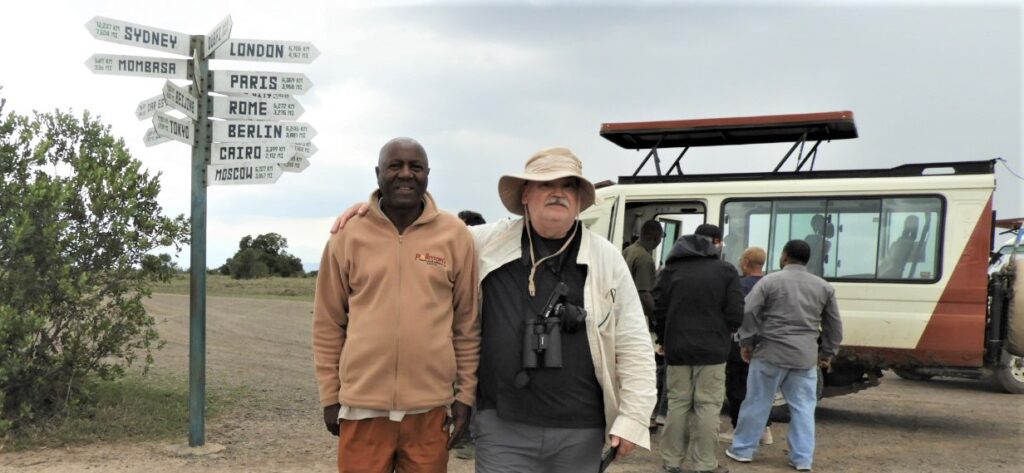Posts Tagged ‘Kenya’
» posted on Thursday, September 15th, 2022 by Linda Lou Burton
They Came To Dance
Linda Lou Burton posting from Sarova Mara Game Camp, Maasai Mara National Reserve, Kenya–I said I wouldn’t miss it. They came to dance, and I was there to watch. It wasn’t 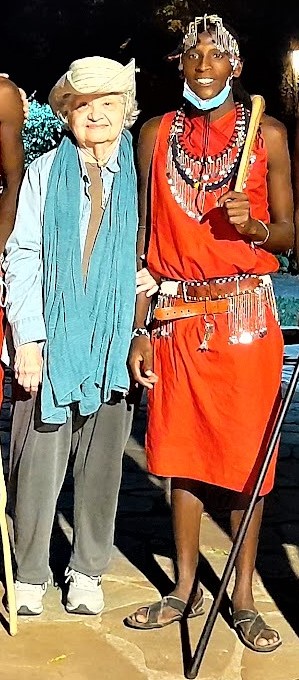 authentic, as far as the setting, and the glittery stuff that sparkled in the artificial light. A stone and concrete patio around a pool of aquamarine water doesn’t speak of tradition. But we got the SOUND of it, the idea of what it was meant to tell us. Our gang was there, part of the tourist crowd. The show was staged for tourists, a group hired by Sarova, or maybe the park itself, to make the rounds of the fancy-schmancy lodges and camps that pepper the Maasai Mara Reserve. That’s a good thing – tourist dollars helping the locals. As for the tourists, it opened the door for us to learn some Maasai history; appreciate their heritage. And that’s a good thing too.
authentic, as far as the setting, and the glittery stuff that sparkled in the artificial light. A stone and concrete patio around a pool of aquamarine water doesn’t speak of tradition. But we got the SOUND of it, the idea of what it was meant to tell us. Our gang was there, part of the tourist crowd. The show was staged for tourists, a group hired by Sarova, or maybe the park itself, to make the rounds of the fancy-schmancy lodges and camps that pepper the Maasai Mara Reserve. That’s a good thing – tourist dollars helping the locals. As for the tourists, it opened the door for us to learn some Maasai history; appreciate their heritage. And that’s a good thing too.
Did you know there are more than a million Maasai? Most live in Kenya, some in Tanzania. Their spoken language is MAA; the name “Maasai” means “people who speak MAA.” Their cows are their most prized possessions – their security, and wealth. Semi-nomadic, they move their homes and herd their cattle in a seasonal rotation. And they hunt lions – never for fun, only if needed to protect their homes and cattle. The Maasai are known for their physical beauty – both their strong, slender, graceful physiques and their unique clothing and body ornamentation. Maasai dress is distinctive, and often copied by fashion designers.
 The SHUKA. Made of animal skins in the beginning; today these wrap-around blankets are woven cotton, purchased, not handmade. The distinctive coloring and fabric design tells of family connection – like the Scottish plaids of the clans. Red is the most-used color; brilliant blues and yellows are used too, in various designs of plaids and stripes and checks. (Online Photo)
The SHUKA. Made of animal skins in the beginning; today these wrap-around blankets are woven cotton, purchased, not handmade. The distinctive coloring and fabric design tells of family connection – like the Scottish plaids of the clans. Red is the most-used color; brilliant blues and yellows are used too, in various designs of plaids and stripes and checks. (Online Photo)
The DANCES. Imagine the dances in the wide open spaces, circled round a fire. Start with the ADAMU, known as the jumping dance. It is joyful, and cocky, a show-off dance. Who can jump the highest? Who is strongest, bravest? Who will attract the best wife? Lots of shouting and whoops, laughter or praise, as each takes a turn stepping in front of the group and jumping as high as he can. The music is created on the spot: voices chanting, modulated, call and response; the perfect soundtrack for what they do; it changes, underscores, leads. The hunting dance; encouragement and morale building as they ready to kill a lion. Friendship and family, celebrating a birth, or a wedding. Grief, and mourning a terrible loss.
We couldn’t follow the words, but the tone and movement told each story well. We asked questions at the end; posed for photos too. I bought a shuka from their table by the pool; the red and black checks my choice. So much to learn about the Maasai, in the days ahead.
Sarova Mara Game Camp https://www.sarovahotels.com/maracamp-masai-mara/
» posted on Thursday, September 15th, 2022 by Linda Lou Burton
Let’s Build Together
 Linda Lou Burton posting from The Great Rift Valley, Narok County, Kenya–And then we got to Narok. An explosion of school buses, school kids in uniform, people, people everywhere. Stores, hospitals, hotels. Cars, buses, helmets on motorbikes. And SIGNS. A giant billboard loomed ahead as Daniel made a right to C12 south; ASANTE plastered all across. P K Ole Ntutu, Governor of Narok County. A new president for the country, new governors as well? Kenya’s 54 million people and 225 million square miles were divided into 47 counties by that 2010 Constitution (replacing the Provincial designations). Over a million of those people live in Narok County, and most of them are Maasai. I knew that “ASANTE” is Thank You in Swahili, but “Pamoja Tujenge”? Let’s Build Together is the translation.
Linda Lou Burton posting from The Great Rift Valley, Narok County, Kenya–And then we got to Narok. An explosion of school buses, school kids in uniform, people, people everywhere. Stores, hospitals, hotels. Cars, buses, helmets on motorbikes. And SIGNS. A giant billboard loomed ahead as Daniel made a right to C12 south; ASANTE plastered all across. P K Ole Ntutu, Governor of Narok County. A new president for the country, new governors as well? Kenya’s 54 million people and 225 million square miles were divided into 47 counties by that 2010 Constitution (replacing the Provincial designations). Over a million of those people live in Narok County, and most of them are Maasai. I knew that “ASANTE” is Thank You in Swahili, but “Pamoja Tujenge”? Let’s Build Together is the translation.
The landscape changed dramatically as we traveled those last 55 miles south to the Maasai Mara National Reserve, part of Narok County too. All the farm-green hills and deep dark soil turned dry; replaced by dust, and scattered rocks. A field of red – Maasai men; a cattle auction going on; red shukas everywhere; cloth cloaks. The design of stripes or plaids is the family trademark, we tried to spot the different families in the crowd. The Loita Plains stretched wide out to our right; the Loita Hills ridged left. Finally, the Sekenani Gate, and just outside, a row of souvenirs, beads and bowls, lined up for the tourist trade. Follow me.
An Observation
The city of Narok is home for our Guide, Abdi Latif, when he’s not away showing people like us around his country. He lives in Narok with his wife and seven children; his mother lives with them too. There are many fine schools in Narok; Daniel stopped to show us one of the ones Abdi had attended. One of the most serious problems in all of Kenya is lack of clean water. Many people have to walk to a water supply; have you noticed the photos of mule-drawn wagons hauling cans of water, or small black tanks installed on the roof of houses and businesses? Abdi is working to install pipelines from a well he has on his property in Narok to serve a school his children attend, as well as others who live in the neighborhood. Let’s hope Narok County’s new governor puts “water needs” high on his agenda.
Narok County Government https://narok.go.ke/
» posted on Tuesday, September 13th, 2022 by Linda Lou Burton
Grandma Hopes
Linda Lou Burton posting from Sweetwaters Serena Camp, Ol Pejeta Conservancy, Nanyuki, Kenya – I was thinking of Elisha as I rested on my tent porch Tuesday afternoon. The gang had set off on another Game Drive after lunch, so I had some  quiet time. I was also thinking of events transpiring in Nairobi at that very moment. William Ruto was being inaugurated as the 5th President of Kenya. It was happening in that big stadium we’d passed on our Sunday tours, the Moi International Sports Center, where 60,000 people could gather. Today had been declared a national holiday. The election had been hard fought, I wondered how things were going.
quiet time. I was also thinking of events transpiring in Nairobi at that very moment. William Ruto was being inaugurated as the 5th President of Kenya. It was happening in that big stadium we’d passed on our Sunday tours, the Moi International Sports Center, where 60,000 people could gather. Today had been declared a national holiday. The election had been hard fought, I wondered how things were going.
Do you know anything of Kenyan history? Are you aware that Kenya was colonized by the British in 1895? It was 1902 when those fertile highlands I’ve been riding through the last few days were opened to white settlers (hence Karen Blixen’s 6,000-acre coffee plantation in 1913). Fast forward to 1963, when the volatility of “whose land is it, anyhow?’(call it a revolution) brought about independence, of a sort, for the folks who lived there first.
 Today, Kenya, a small and beautiful multi-ethnic country on the east coast of Africa with 42 tribes and about 60 languages (English and Swahili most prolific) is a “presidential representative democratic republic.” Over the last 59 years it has altered its constitution many times; political parties have come and gone; and corruption has left its mark.
Today, Kenya, a small and beautiful multi-ethnic country on the east coast of Africa with 42 tribes and about 60 languages (English and Swahili most prolific) is a “presidential representative democratic republic.” Over the last 59 years it has altered its constitution many times; political parties have come and gone; and corruption has left its mark.
Will William Ruto make a difference?
Wait, you may be thinking. He is only the 5th president in 59 years? Well yes, here’s the list; fascinating to read about who did the most good, and the most harm, during their long terms. Worth looking them up if you want to dig deeper. From 1963-1964 British rule was winding down with Queen Elizabeth II as monarch; Jomo Kenyatta was Prime Minister.
- 1964-1978: Jomo Kenyatta, President (14 years)
- 1978-2002: Daniel Moi, President (24 years)
- 2002-2013: Mwai Kibaki, President (11 years)
- 2013-2022: Uhuru Kenyatta, President (son of Jomo, 9 years)
The Constitution of 2010 set term limits at 5 years, allowing two consecutive terms.
Rick arrived back at our tent a little after 5. “Guess what!” he said. “After the Game Drive we got to watch a video of the inauguration on TV!” He showed me a picture he’d taken of the screen, and told me that the proceedings went smoothly.
“Speaking of pictures,” I said, “you took a picture of Elisha and me this morning. Can I see that?” Elisha’s story, and Ruto’s inauguration seemed somehow connected in my mind.
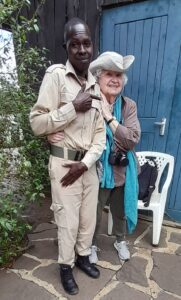 Here’s the picture of Elisha and me. I met him today, just before we stopped at the Equator. I was sitting in a white chair this time, in the shade outside the Chimpanzee Sanctuary’s Visitor Center. Once again, I’d requested a place to sit while everyone else stood, and walked, and followed the guide along the pathways to the enclosures. And once again, someone had been asked to “look after” the gray-headed lady who moved slowly, slowly, “pole, pole.” After we’d exchanged names, I asked how long he’d worked there. “Two years,” he answered, and then Elisha told me his story.
Here’s the picture of Elisha and me. I met him today, just before we stopped at the Equator. I was sitting in a white chair this time, in the shade outside the Chimpanzee Sanctuary’s Visitor Center. Once again, I’d requested a place to sit while everyone else stood, and walked, and followed the guide along the pathways to the enclosures. And once again, someone had been asked to “look after” the gray-headed lady who moved slowly, slowly, “pole, pole.” After we’d exchanged names, I asked how long he’d worked there. “Two years,” he answered, and then Elisha told me his story.
“I first got a job building fences,” he said. “I was the oldest of seven children and since my father had died, it was my responsibility to look after the family. My mother determined that I get the best education possible, so I did. I graduated with honors! But the only job I could find right away was as a fence builder, digging post holes, and stringing wire. I was able to bring a little money in with that, but knew I had to do better. So I kept applying for jobs, every time I learned of an opening. It took me five years to get this job,” he said, looking around the grounds of the Sanctuary. “I put in four applications and had four interviews. I actually cried when I got the letter telling me I was hired. There are simply more college graduates than jobs available.” We continued talking for a long while; about life, about responsibility, about how important our family is.
And then the group finished the tour and came to find me. Someone asked Elisha if they could get his picture in his handsome uniform, and he replied “Only if you get her picture with me. She’s my Grandma.” I stood up and gave Elisha a very proud grandmotherly hug.
William Ruto’s inaugural address included these words.
It is time for us to stem the tide of youth unemployment. Every year, 800,000 young people join the workforce and over 600,000 of them do not find opportunities for productive work. Moreover, our young people in cities and towns face very hostile environments, many times treated as a nuisance….Our immediate agenda is to create a favorable business and enterprise environment…and support people in the informal sector to organize themselves into stable, viable and creditworthy business entities. This is the essence of the bottom-up economic model, which creates a path for traders and entrepreneurs to build linkages, experience safety, and enjoy security.
I so hope that works out.
» posted on Tuesday, September 13th, 2022 by Linda Lou Burton
Smack Dab in the Middle
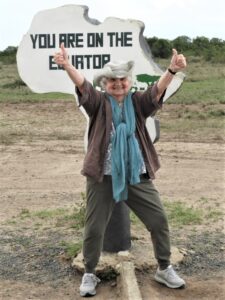 Linda Lou Burton posting from Sweetwaters Serena Camp, Ol Pejeta Conservancy, Nanyuki, Kenya – Here’s the second reason I went to Africa. First Karen Blixen’s house. Now, the EQUATOR. I’ve been to the Arctic and the Antarctic, now I was smack dab in the middle, the fattest part of EARTH. Hot dog!
Linda Lou Burton posting from Sweetwaters Serena Camp, Ol Pejeta Conservancy, Nanyuki, Kenya – Here’s the second reason I went to Africa. First Karen Blixen’s house. Now, the EQUATOR. I’ve been to the Arctic and the Antarctic, now I was smack dab in the middle, the fattest part of EARTH. Hot dog!
I wasn’t the only person there who was acting like a nut. We’d been sitting in the 4x4s since early morning and this was our last stop before lunch. We were running around like fools. “Get it on record! We’re at the Equator!”
I mean, this is serious stuff. That big tall sign was bragging too, with a bunch of “get this” facts about THE EQUATOR.
- It has the fastest sunrises and sunsets.
- It crosses through 13 different countries.
- It always has exactly 12 hours of day and 12 hours of night.
- It has just two equinoxes when the sun is directly above – March and September.
- It holds the world’s greatest concentration of biodiversity.
- It passes through 50% of the world’s rainforest in three countries – Brazil, Congo, and Indonesia.
- Only 20% of the world’s population live below the Equator.
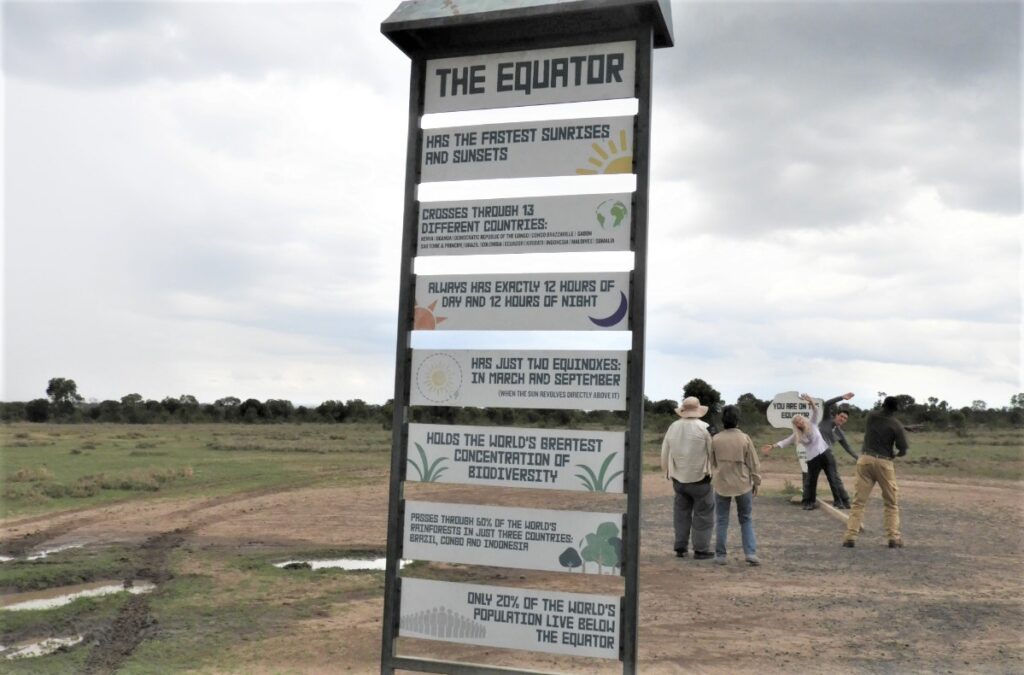 See Lois and Mike back there clowning, Guide Abdi giving them directions, Rick and Judy watching. Everybody was lining up for their turn to be ON the Equator, right there near our tent camp at Sweetwaters; right there in Ol Pejeta; right there in Kenya; right there in Africa.
See Lois and Mike back there clowning, Guide Abdi giving them directions, Rick and Judy watching. Everybody was lining up for their turn to be ON the Equator, right there near our tent camp at Sweetwaters; right there in Ol Pejeta; right there in Kenya; right there in Africa.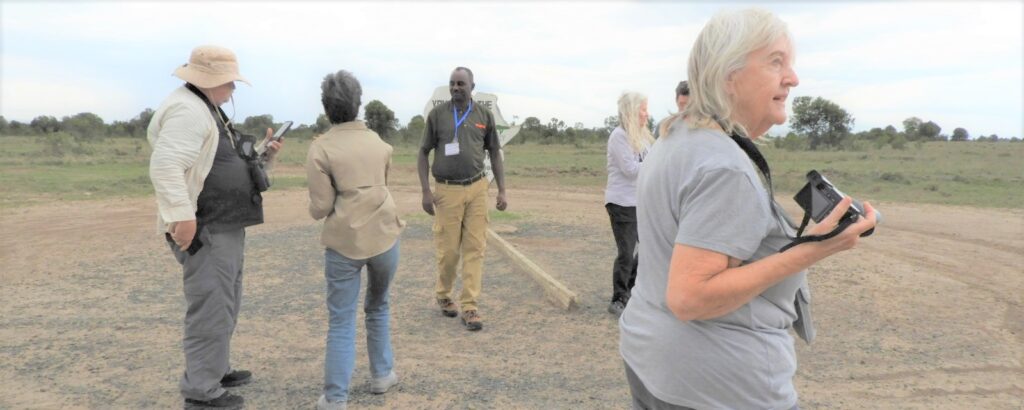
Here’s a record of our cuteness.
Rick Pointing * Rick South & Me North * Me South & Rick North * Venita South & Otis North * Ed & Maureen North * Driver Frank & The Way to Sydney * Driver Daniel & Rick & Our 4×4
» posted on Monday, September 12th, 2022 by Linda Lou Burton
Didn’t Miss A Thing
Linda Lou Burton posting from Sweetwaters Serena Camp, Ol Pejeta Conservancy, Nanyuki, Kenya – Ever get to a place and just want to stay forever? Ever sit on a front porch and just breathe, content to do absolutely nothing? Ever had guinea fowl make such a racket you stood up to look for invaders in your yard? Believe it or not, all those things happened to me, and to Rick, in our first hour at Tent #16, Sweetwaters Serena. I’d never even heard of guinea fowl before! More precisely, I’d never HEARD guinea fowl, but that awful sound got us up and looking for the problem.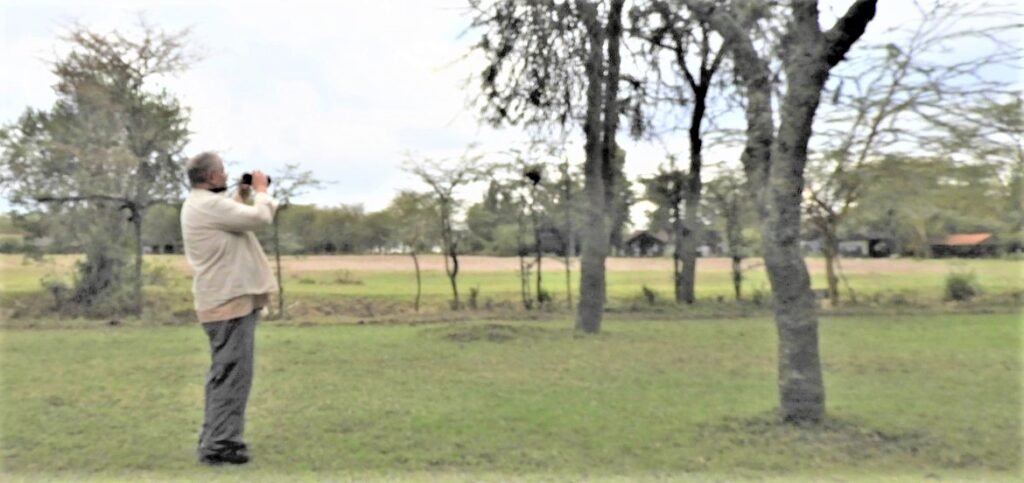
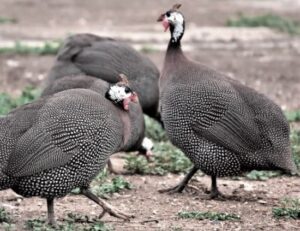 The porch of our fancy-schmancy tent faced the water hole, a distance away past the tree line. And something over there was excited; it sounded like dogs-with-a-terrible-cold barking. Use your expertise to google “guinea-fowl sounds” and you’ll see what I mean. That’s what Rick did, as we finally spotted the “helmeted chickens” all in a fuss about something. They are known as “alarmists” and considered useful (on a farm, or a wildlife preserve?) for sensing trouble.
The porch of our fancy-schmancy tent faced the water hole, a distance away past the tree line. And something over there was excited; it sounded like dogs-with-a-terrible-cold barking. Use your expertise to google “guinea-fowl sounds” and you’ll see what I mean. That’s what Rick did, as we finally spotted the “helmeted chickens” all in a fuss about something. They are known as “alarmists” and considered useful (on a farm, or a wildlife preserve?) for sensing trouble.
All that activity got Rick excited to see more animals, so he headed off to meet Abdi and Daniel and Frank and the rest of the gang for the very first Game Drive. In those 4x4s. Eek! “I’m not going anywhere!” I said. “A 5:30 wakeup today! A 5-hour drive with all that bumping and jabbering! I’m taking a NAP.”
 Ahhh, peace and quiet. The guinea fowl settled down. The rain began, the kind of rain that politely falls without a mess, and whispers you to sleep. I headed inside. I’ve done some camping in my day. I’ve slept in pop-up tents, with sleeping bag on the ground, campfire for cooking, and potty relief behind the nearest tree. My Sweetwaters tent was nothing like THAT. It’s called a “permanent tent” set up on a concrete (tiled and carpeted) floor, with a permanent thatched roof above.
Ahhh, peace and quiet. The guinea fowl settled down. The rain began, the kind of rain that politely falls without a mess, and whispers you to sleep. I headed inside. I’ve done some camping in my day. I’ve slept in pop-up tents, with sleeping bag on the ground, campfire for cooking, and potty relief behind the nearest tree. My Sweetwaters tent was nothing like THAT. It’s called a “permanent tent” set up on a concrete (tiled and carpeted) floor, with a permanent thatched roof above.
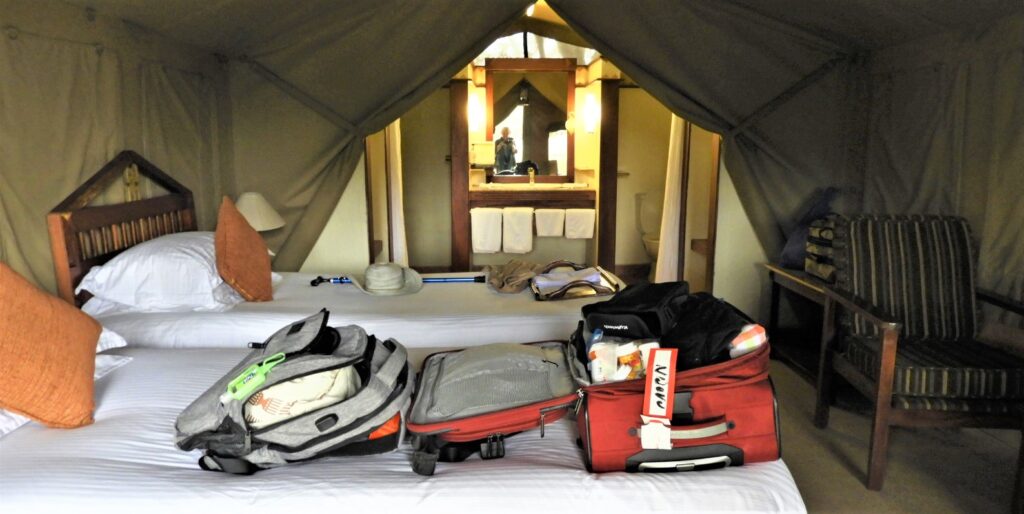 Sweetwaters Serena has 56 such tents; some are on raised platforms with balconies; ours was nearer the water hole, with a porch. Two comfy double beds. Two closets. Two robes. Two chairs inside; two out. Wi-fi and coffee station. Bath with tile shower, flush toilet, stacks of towels. Electricity! It qualified as “tented camping” because, in fact, all of this WAS inside a (very well protected) canvas tent. With windows and doors that zipped open, and closed. I left the door unzipped, and went to sleep with nary a dream of being devoured by a lion, as those who’ve-never-been-to-Africa predicted would be my demise.
Sweetwaters Serena has 56 such tents; some are on raised platforms with balconies; ours was nearer the water hole, with a porch. Two comfy double beds. Two closets. Two robes. Two chairs inside; two out. Wi-fi and coffee station. Bath with tile shower, flush toilet, stacks of towels. Electricity! It qualified as “tented camping” because, in fact, all of this WAS inside a (very well protected) canvas tent. With windows and doors that zipped open, and closed. I left the door unzipped, and went to sleep with nary a dream of being devoured by a lion, as those who’ve-never-been-to-Africa predicted would be my demise.
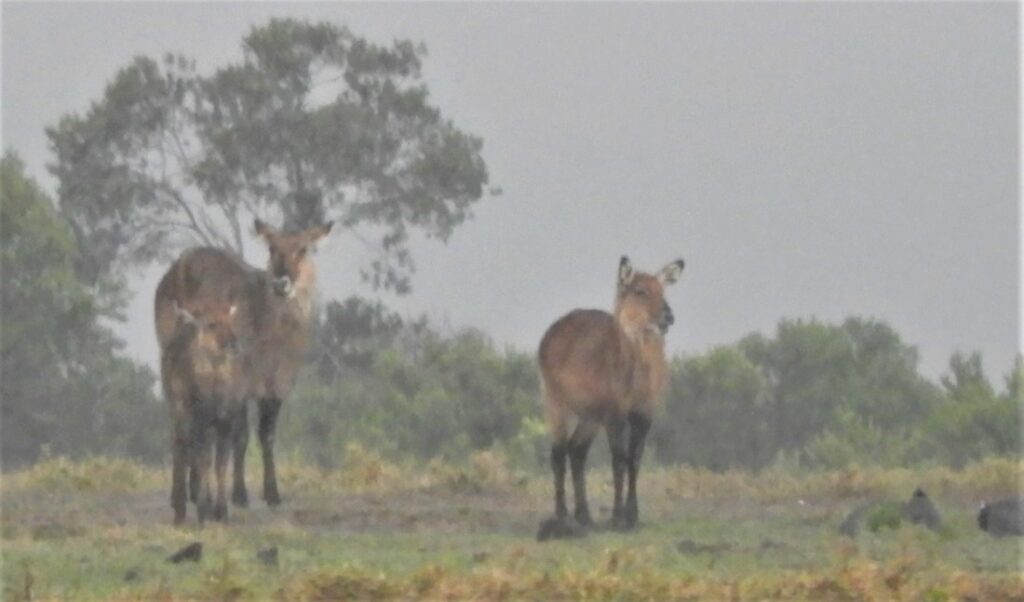 An awful squawking woke me. I’d slept an hour or so, felt rested now. I walked to the porch; a misty fog replaced the rain. I couldn’t see the water hole; zoomed my camera; caught something moving far away. It was a mother and baby impala (I think, white ears rimmed in black), with a younger impala standing peacefully beside. Coming up on the right I could see the squawking guinea fowl.
An awful squawking woke me. I’d slept an hour or so, felt rested now. I walked to the porch; a misty fog replaced the rain. I couldn’t see the water hole; zoomed my camera; caught something moving far away. It was a mother and baby impala (I think, white ears rimmed in black), with a younger impala standing peacefully beside. Coming up on the right I could see the squawking guinea fowl.
The gang would be back from their Game Drive soon, I realized. Dinner in the Rhino Room began at 7; everybody chattering; what they saw; what they did; what I missed.
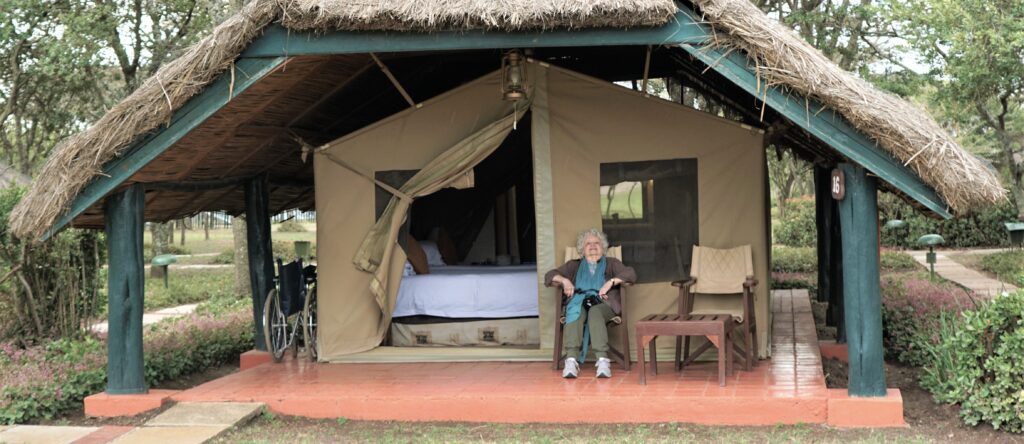 I didn’t miss a thing. There’s just something about a porch.
I didn’t miss a thing. There’s just something about a porch.
Sweetwaters Serena, Ol Pejeta Conservancy, Kenya https://www.serenahotels.com/sweetwaters
» posted on Monday, September 12th, 2022 by Linda Lou Burton
Better Than Disney
Linda Lou Burton posting from Sweetwaters Serena Camp, Ol Pejeta Conservancy, Nanyuki, Kenya – Ol Pejeta Conservancy is – well, it’s better than Disneyland! For animal lovers – it offers more than any zoo you’ve ever been to. For nature lovers – it offers more change of scene than any hike you’ve ever walked in the remotest of hills. For sheer accomplishment and impact, well, read on, in fact, go to THEIR website and spend the day learning about this magnificent place on the Equator in the foothills of Mt Kenya. https://www.olpejetaconservancy.org/
 Here are a few basics about Ol Pejeta.
Here are a few basics about Ol Pejeta.
- It’s a not-for-profit wildlife conservancy in Central Kenya’s Laikipia County, providing “innovative, tangible, sustainable conservation for wildlife and people.”
- It’s big, and broad – 90,000 acres containing 4 key habitats (plains, riverine, wetlands and mixed acacia bushland), hundreds of species and thousands of animals, and is surrounded by a population of more than 50,000 people.
- It’s home to the Big Five – lion, leopard, elephant, cape buffalo, and rhinoceros – as well as giraffes, hippos, hyenas, baboons, and endangered species like the African wild dog, cheetah and oryx.
- It’s the largest black rhino sanctuary in East Africa, with a population of over 140 black rhinos, a critically endangered species.
- It’s home to the world’s last two remaining northern white rhinos. Najin, 32, and her daughter Fatu, who is in her twenties, live in a 700-acre 24-hour secured enclosure. The last male of the species, Sudan, died in 2018.
- It’s the only place in Kenya to see chimpanzees, in a sanctuary established to rehabilitate animals rescued from the black market.
- It’s home to a herd of 6,000 bush-savvy purebred Boran cattle. Livestock-wildlife integration is beneficial to the grassland as bunched grazing breaks hardpan soil and fertilizes the ground.
- It’s supporting the people living around its borders through infrastructure and economic projects and education and healthcare efforts.
Good news for you, and me, Ol Pejeta welcomes and embraces visitors! It offers nine tented camps (Globus booked us into Sweetwaters Serena), lodges and homestays, and five campsites. Do you want pampered luxury and table-waited dining, or camping in the wild (you know, those middle-of-the night sounds when animals scratch around your tent)? Either way, you’ll wake up surrounded by NATURE, with the chance of more adventure than, well, that other place I mentioned.
And the RIDES at Ol Pejeta are in open-air 4x4s splashing through rocky creekbeds in pursuit of the latest reported elephant sighting, or pausing to watch a baby rhino and its mom feeding in the quiet of wide-open spaces, or the dark of night when the spotter’s light catches a lion couple in repose.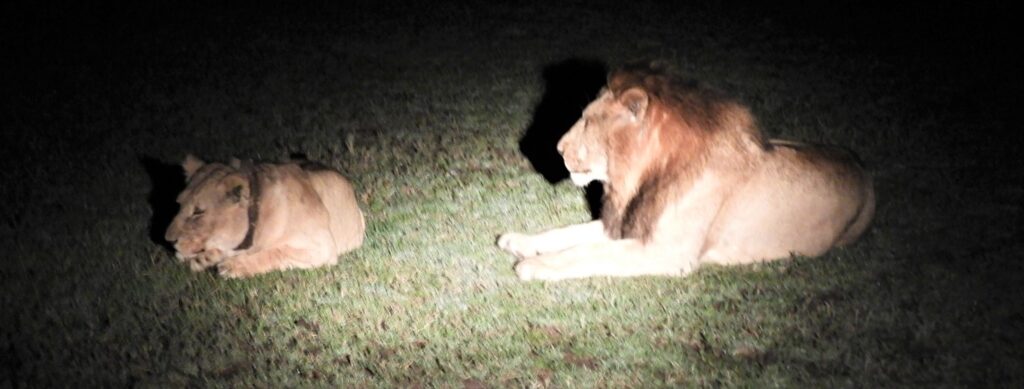
It’s a Trip Advisors Travelers Choice again this year, and 100% of profits from tourist dollars are reinvested into conservation and community development. A visit isn’t just good for you, it’s good for Kenya’s natural heritage, and its people.
The Animals: Ol Pejeta Wildlife https://www.olpejetaconservancy.org/wildlife/
The Projects: Ol Pejeta Conservation https://www.olpejetaconservancy.org/conservation/
Places to Stay and Things To Do: Ol Pejeta Escapes https://www.olpejetaconservancy.org/ol-pejeta-escapes/
Get Involved Wherever You Are: https://www.olpejetaconservancy.org/get-involved/
» posted on Sunday, September 11th, 2022 by Linda Lou Burton
Face to Face
 Linda Lou Burton posting from Nairobi, Kenya –Sunday morning in Nairobi and our Globus Tour begins today! It was a pre-safari day, a day for exploring Nairobi; and Rick and I were the only two signed up. Our Globus Guide for the day, Blethwell, and our driver, Daniel, met us in the lobby just at 9 AM, reviewed the day’s itinerary, and escorted us to our Globus 6-passenger transport. Our first stop: the Giraffe Centre.
Linda Lou Burton posting from Nairobi, Kenya –Sunday morning in Nairobi and our Globus Tour begins today! It was a pre-safari day, a day for exploring Nairobi; and Rick and I were the only two signed up. Our Globus Guide for the day, Blethwell, and our driver, Daniel, met us in the lobby just at 9 AM, reviewed the day’s itinerary, and escorted us to our Globus 6-passenger transport. Our first stop: the Giraffe Centre.
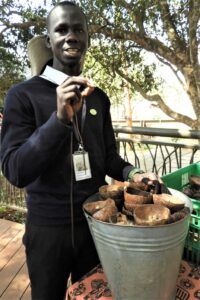 It was an 11-mile drive to the Centre on Duma Road, where our first directive was to “wash our hands.” Just by the front gate, sinks and sanitizers were part of the “allowing in” process. Then a walk up a winding ramp to a stop for a pellet-filled coconut shell (the green pellets are alfalfa, the tan are corn and molasses, guess which was the favorite!). “Hold the pellet between thumb and forefinger and lay it gently on the giraffe’s tongue. Do not lay the pellets out flat in your palm.”
It was an 11-mile drive to the Centre on Duma Road, where our first directive was to “wash our hands.” Just by the front gate, sinks and sanitizers were part of the “allowing in” process. Then a walk up a winding ramp to a stop for a pellet-filled coconut shell (the green pellets are alfalfa, the tan are corn and molasses, guess which was the favorite!). “Hold the pellet between thumb and forefinger and lay it gently on the giraffe’s tongue. Do not lay the pellets out flat in your palm.”
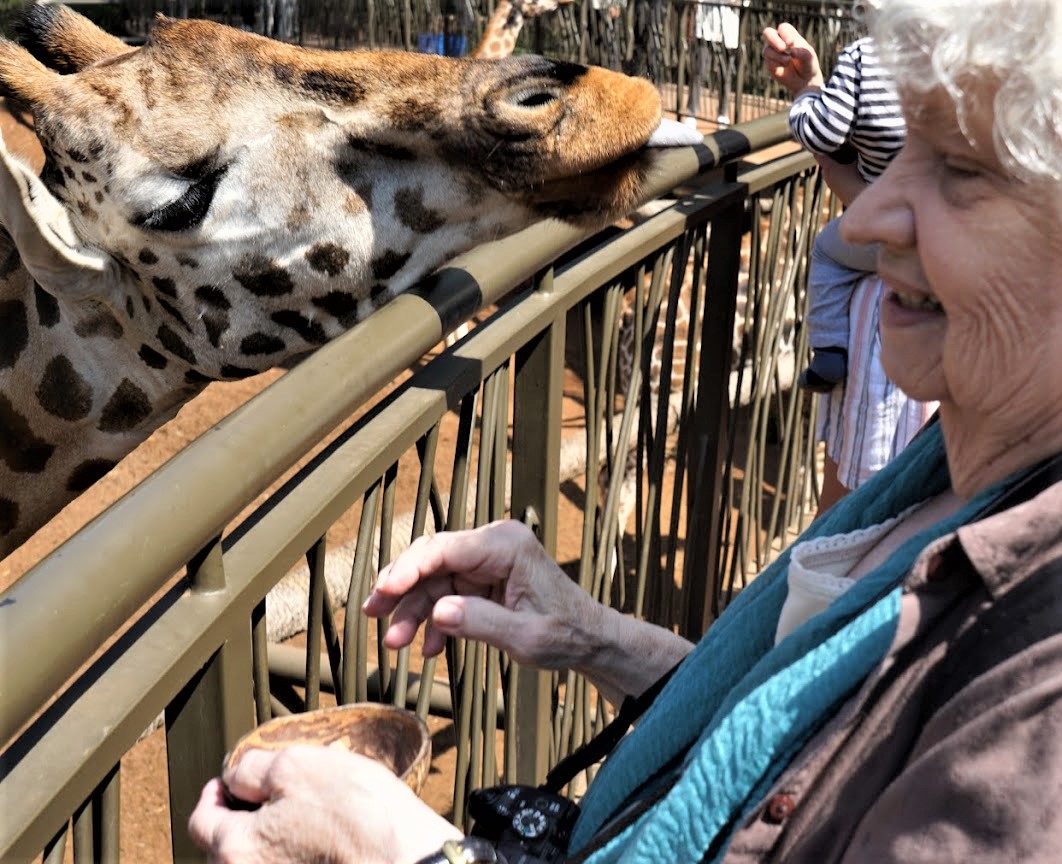
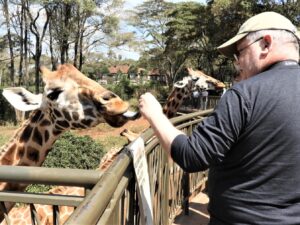
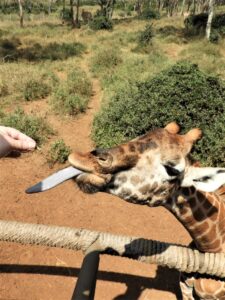 Armed with coconut shells and cameras, we stepped onto the platform that put us FACE TO FACE with the Long Tall Sallys of the animal world. First thing to note: these giraffes were polite but not shy as they fluttered those movie-star eyelashes, extended their long gray-velvet tongues, and downed our offered pellets. Everyone on the ramp was giggling, age no issue. A kid on his Daddy’s shoulders. A gray-headed granny. It was just plain fun.
Armed with coconut shells and cameras, we stepped onto the platform that put us FACE TO FACE with the Long Tall Sallys of the animal world. First thing to note: these giraffes were polite but not shy as they fluttered those movie-star eyelashes, extended their long gray-velvet tongues, and downed our offered pellets. Everyone on the ramp was giggling, age no issue. A kid on his Daddy’s shoulders. A gray-headed granny. It was just plain fun.
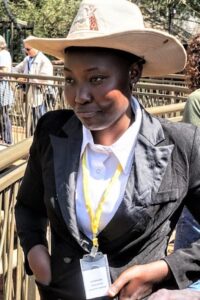 Eunice, the Ranger who was answering questions right and left, called out the names of each giraffe; told us of their good, and bad,
Eunice, the Ranger who was answering questions right and left, called out the names of each giraffe; told us of their good, and bad, 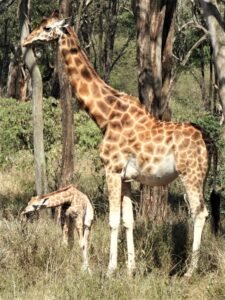 habits. She pointed to the mother and baby standing back under the trees. “The baby is so new we haven’t gotten close enough yet to know if it is male or female,” she told me. I studied Mama and Baby, commenting “A baby has a long way to fall, are they ever injured?”
habits. She pointed to the mother and baby standing back under the trees. “The baby is so new we haven’t gotten close enough yet to know if it is male or female,” she told me. I studied Mama and Baby, commenting “A baby has a long way to fall, are they ever injured?”
The answer: giraffes enter the world front legs and head first, followed by their body, and then back legs. Mama stands for the birth because – well the baby is BIG and its neck is LONG; the 6-foot drop from womb to ground snaps the umbilical cord, tears the birth sac open, and stimulates the baby to take its first breaths. Baby is up and walking within hours, ready to feed, and ready to run, if need be. This protected baby didn’t have a worry!
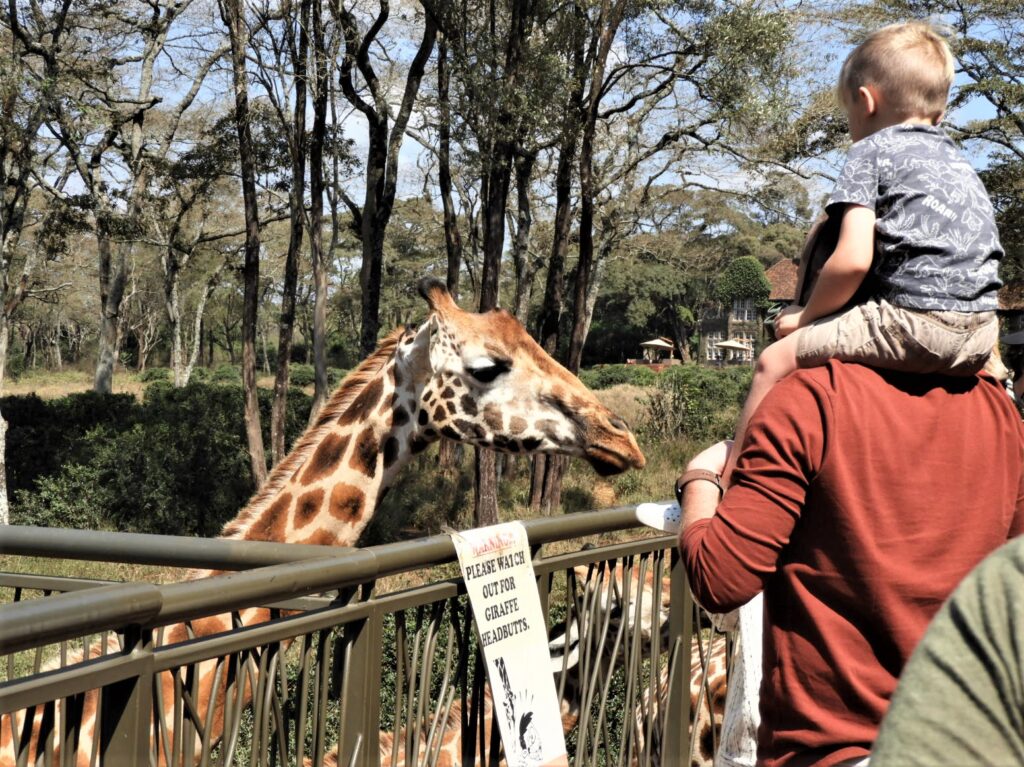 The Giraffe Centre is the creation of the African Fund for Endangered Wildlife (AFEW), a Kenyan non-profit organization. Its main purpose is to educate Kenyan school children and youth on their country’s wildlife and environment, as well as give local and international visitors an opportunity to come into close contact with the world’s tallest species.
The Giraffe Centre is the creation of the African Fund for Endangered Wildlife (AFEW), a Kenyan non-profit organization. Its main purpose is to educate Kenyan school children and youth on their country’s wildlife and environment, as well as give local and international visitors an opportunity to come into close contact with the world’s tallest species. 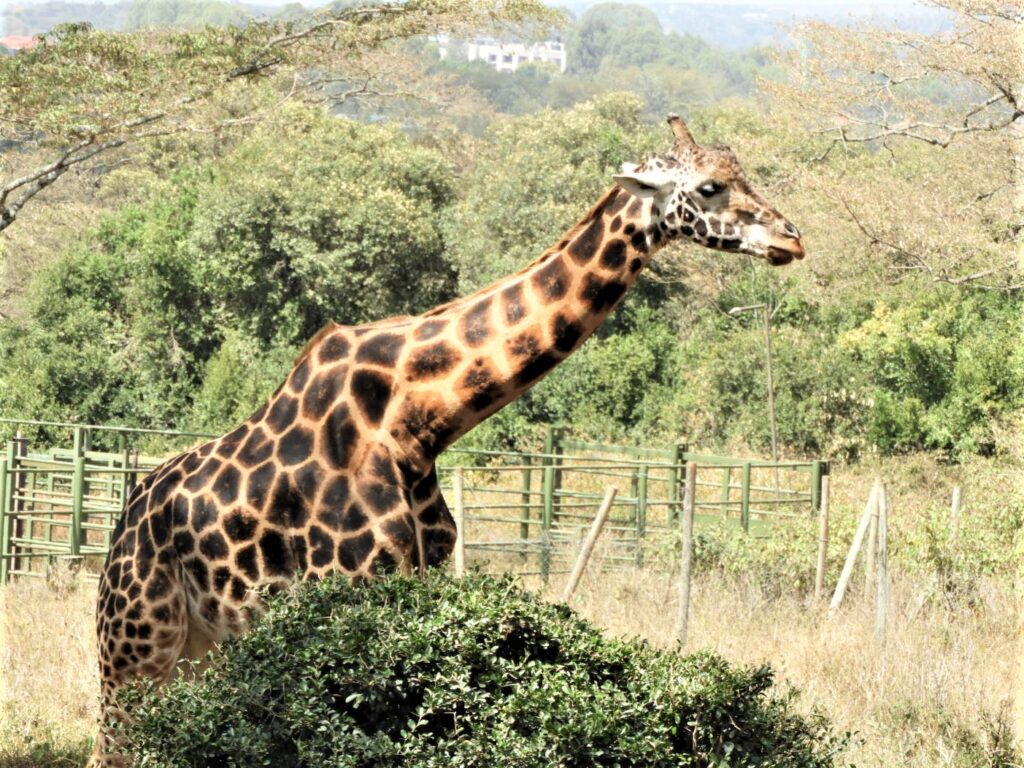
The AFEW was founded in 1979 by Jock Leslie-Melville, a Kenyan citizen of British descent, and his American-born wife, Betty, after discovering the sad plight of the Rothschild Giraffe, a subspecies of giraffe found only in the grasslands of East Africa. At the time, the animals had lost their habitat in Western Kenya, with only 130 of them left. Jock and Betty brought two young giraffes to their home in a Nairobi suburb, Langata, where they started a program of 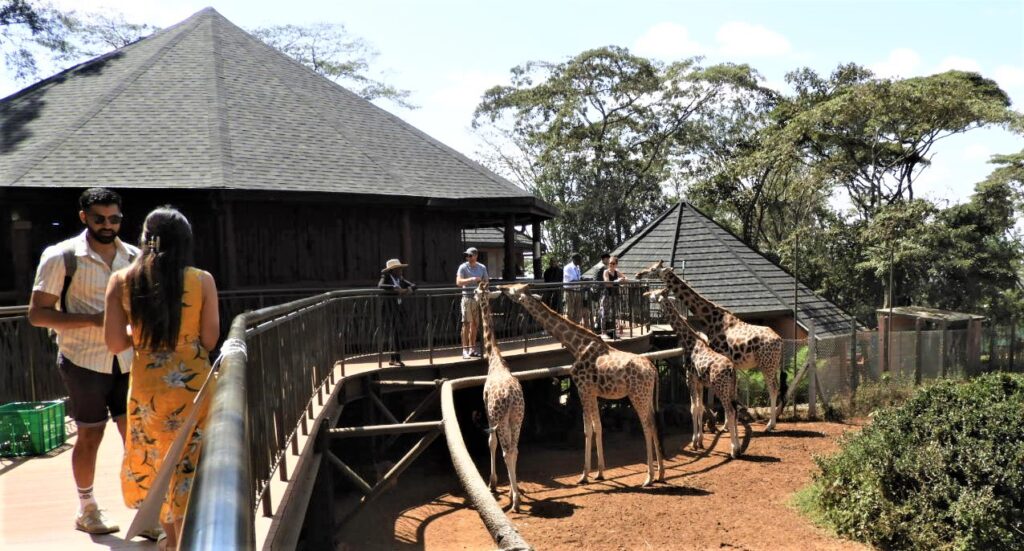 breeding giraffes in captivity. This is where the Centre remains today. In 1983, funds raised by AFEW USA helped build the Educational Centre on this 60-acre sanctuary. The Giraffe Centre opened its doors to the general public and students the same year. There are now over 300 Rothschild Giraffes living safely and breeding well in various Kenyan national parks.
breeding giraffes in captivity. This is where the Centre remains today. In 1983, funds raised by AFEW USA helped build the Educational Centre on this 60-acre sanctuary. The Giraffe Centre opened its doors to the general public and students the same year. There are now over 300 Rothschild Giraffes living safely and breeding well in various Kenyan national parks.
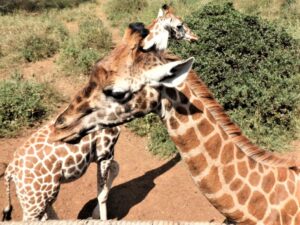 If you can’t make it to Nairobi, then go to the Centre’s website to learn more about the seven females — Betty, the oldest; Kelly, Daisy IV, Salma II, Margaret, Nandi, and Lilly — and the three males, Olerai, Mpingo, and Edd, 18 feet tall and the friendliest; he is father to all the calves. Keep up with the babies via the blogs. And oh yes, a warthog family lives there too! Here’s the link to the site, lots of video. They love donations, be generous.
If you can’t make it to Nairobi, then go to the Centre’s website to learn more about the seven females — Betty, the oldest; Kelly, Daisy IV, Salma II, Margaret, Nandi, and Lilly — and the three males, Olerai, Mpingo, and Edd, 18 feet tall and the friendliest; he is father to all the calves. Keep up with the babies via the blogs. And oh yes, a warthog family lives there too! Here’s the link to the site, lots of video. They love donations, be generous.
Giraffe Centre: https://www.giraffecentre.org/
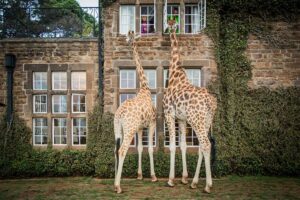 If you CAN go to Nairobi, and really want to get Face to Face, book a stay at the Giraffe Manor, a hotel which is part of the same property (see in background of other photos). In the second-floor suites of the Manor, those same giraffes Rick and I had so much fun feeding might just stick their head in your bedroom window and give you a wake-up call. This is what I call Totally Awesome. Stay in Jock’s Room, or Betty’s, or the Karen Blixen Suite. For a price! Put it on your Bucket List?
If you CAN go to Nairobi, and really want to get Face to Face, book a stay at the Giraffe Manor, a hotel which is part of the same property (see in background of other photos). In the second-floor suites of the Manor, those same giraffes Rick and I had so much fun feeding might just stick their head in your bedroom window and give you a wake-up call. This is what I call Totally Awesome. Stay in Jock’s Room, or Betty’s, or the Karen Blixen Suite. For a price! Put it on your Bucket List?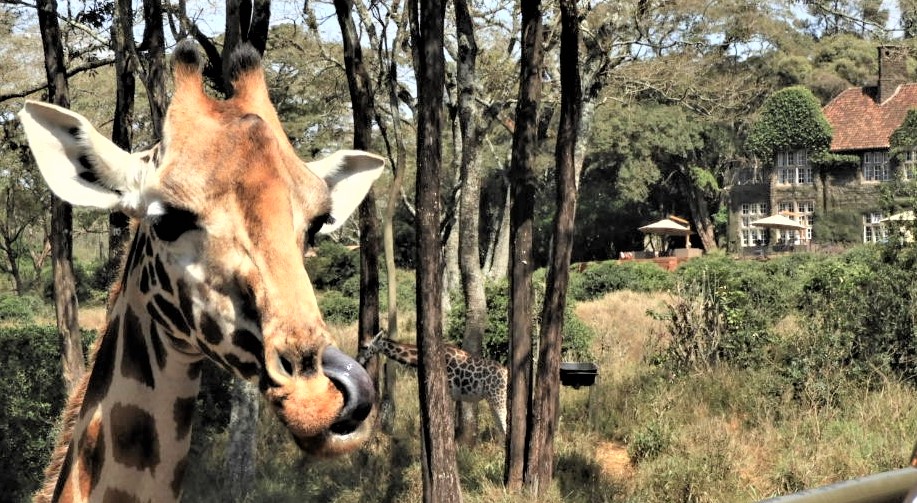
Giraffe Manor: https://www.thesafaricollection.com/properties/giraffe-manor/
Giraffes should be regarded as “intelligent, group-living mammals which have evolved highly successful and complex societies, which have facilitated their survival in tough, predator-filled ecosystems.”
» posted on Friday, September 9th, 2022 by Linda Lou Burton
Attitude at Latitude
Linda Lou Burton posting from Little Rock, Arkansas; Chicago, Illinois; Frankfurt, Germany; and Nairobi, Kenya –Are climate and manners related? I mean – are people in warmer climes just naturally friendlier and warmer? Now, don’t get huffy about stereotyping, just listen to this.
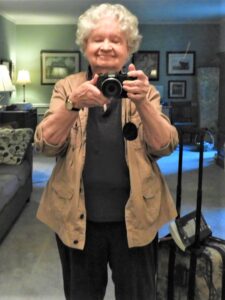 Son Rick and I couldn’t do the “on-line check-in” that United was asking us to do first thing Thursday morning. The SYSTEM said we had to have a seat number to check in online, but the system wouldn’t give us a seat number until we entered all health information from our pre-school vaccinations to the latest COVID booster. Holy crap! We both had our QR Codes telling all; we had all our Visas; we had our Yellow Fever Card officially stamped by state health officials. But no matter what we scanned or what lengthy numbers we entered, some unknown gremlin would not RECOGNIZE us. You know that early-morning stomach knot when technology blocks tenacity? Best to get to the airport early and ask a HUMAN for help.
Son Rick and I couldn’t do the “on-line check-in” that United was asking us to do first thing Thursday morning. The SYSTEM said we had to have a seat number to check in online, but the system wouldn’t give us a seat number until we entered all health information from our pre-school vaccinations to the latest COVID booster. Holy crap! We both had our QR Codes telling all; we had all our Visas; we had our Yellow Fever Card officially stamped by state health officials. But no matter what we scanned or what lengthy numbers we entered, some unknown gremlin would not RECOGNIZE us. You know that early-morning stomach knot when technology blocks tenacity? Best to get to the airport early and ask a HUMAN for help.
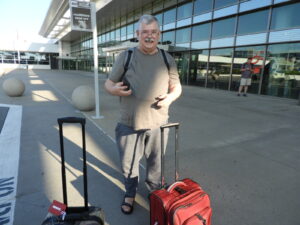 I snapped a goodbye photo and said one last farewell to Katy Cat, then we were gone. Uber dropped us at Little Rock’s Clinton National at 8:30 am and we bravely approached a CLOSED section of the United counter, where we spotted a young woman just getting ready to open up. No line. I leaned on my cane, and smiled at her. She smiled back. I explained our predicament, laying out all our official documents. Rick showed her his phone, with all the United refusals to recognize us. She made suggestions, then took the phone herself. She called someone else over to look. Now, two heads trying to figure it out.
I snapped a goodbye photo and said one last farewell to Katy Cat, then we were gone. Uber dropped us at Little Rock’s Clinton National at 8:30 am and we bravely approached a CLOSED section of the United counter, where we spotted a young woman just getting ready to open up. No line. I leaned on my cane, and smiled at her. She smiled back. I explained our predicament, laying out all our official documents. Rick showed her his phone, with all the United refusals to recognize us. She made suggestions, then took the phone herself. She called someone else over to look. Now, two heads trying to figure it out.
“You have everything you need,” she said. “There is NO REASON this won’t go through!” A male employee approached, with a box of donuts in hand, a morning treat he was bringing to share with our kindly helper. Hugs all around, thank yous for the donuts, and soon, the man was drawn into our dilemma too. FIVE OF US, shaking our heads. AND THEN, our kindly helper started clicking away on her keyboard, and printed out four boarding passes. “Here,” she said. “Don’t worry about it. You are now checked in all the way through Chicago and Frankfurt to Nairobi.”
“What did you do?” I asked. “I overrode the system,” she said. “I’ve seen your documents. Now, have a great trip!” Rick and I just stared, bug-eyed. And then, RELIEF! We thanked our kindly helper. “Please come around the counter,” I said to her. “I want to give you a hug!” She did. I did. The man who’d brought the donuts came around too. More hugs. More thank yous. “You are an inspiration to me,” he said. “Going on such an adventure at 83!” He admitted to being in his 60s. “I thought I was too old to travel,” he said, “but you are proof I’m not!”
 I’d asked for wheelchair assistance for both myself, and for Rick, who is in his 60s and almost as bumbly as me. We had done the advance work of getting a KTN (Known Traveler Number) which SHOULD have made getting through security easier; at least, in the US. Still, it took a while, but our loyal Wheelchair Assistants kept pushing our chairs and pulling our bags, helping with absolutely everything, till we reached our gate as Approved Travelers. Our short flight north to Chicago’s O’Hare was pleasant – from my window seat I got shots of the
I’d asked for wheelchair assistance for both myself, and for Rick, who is in his 60s and almost as bumbly as me. We had done the advance work of getting a KTN (Known Traveler Number) which SHOULD have made getting through security easier; at least, in the US. Still, it took a while, but our loyal Wheelchair Assistants kept pushing our chairs and pulling our bags, helping with absolutely everything, till we reached our gate as Approved Travelers. Our short flight north to Chicago’s O’Hare was pleasant – from my window seat I got shots of the 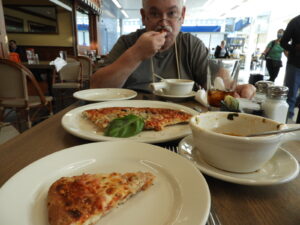 Mississippi River, then the Chicago skyline, and Lake Michigan. A beautiful day! Wheelchair Assistance was great there too; brisk, lively conversation as we were wheeled down corridors, onto trains, and through more security proving our travel worthiness. No hugs, but we were taken to our gate in plenty of time to meander to a restaurant for some Chicago pizza.
Mississippi River, then the Chicago skyline, and Lake Michigan. A beautiful day! Wheelchair Assistance was great there too; brisk, lively conversation as we were wheeled down corridors, onto trains, and through more security proving our travel worthiness. No hugs, but we were taken to our gate in plenty of time to meander to a restaurant for some Chicago pizza.
Then it was time to board our Lufthansa flight to Frankfurt. Our boarding passes showed seats 47E and 47F, the worst of the worst, smack dab in the middle of the middle and far from 1st Class spaciousness. Plus we had to enter down different aisles. As I pushed my bag along (we were allowed one bag under 33 pounds and one backpack on this Globus Safari) the aisle got narrower and narrower. I finally reached row 47, where an attendant, dressed in a spiffy Lufthansa uniform complete with hat and heels, was standing.
“You have to put that bag UP,” she said brusquely. “ I need some help,” I answered (remember, Rick was in the other aisle, four seats away). “Well, I can’t help you,” she said. “That bag looks HEAVY.” “It is too heavy for me,” I answered. “I can’t lift it above my head.” (Yes, I had my cane in one hand, and my backpack on my back.) She angrily took my bag and shoved it into the overhead. “I am NOT supposed to do this!” she shouted. “I have a BAD BACK.”
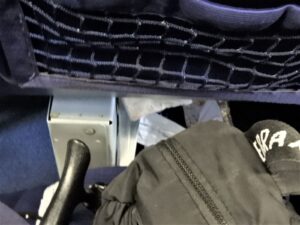 I thanked her for her help and took my seat, climbing over the aisle seat to a seat that had a metal BOX installed under the seat in front. There was no place to store my backpack! No foot room! About that time Rick arrived via the other aisle, as the attendant complained to one of her co-staff “People ask ME to lift things! I have a BAD BACK. People are so RUDE to me! We are NOT supposed to lift anything heavy. Then we get hurt and can’t work and they dock us our pay! It isn’t FAIR to ask us to LIFT THINGS!”
I thanked her for her help and took my seat, climbing over the aisle seat to a seat that had a metal BOX installed under the seat in front. There was no place to store my backpack! No foot room! About that time Rick arrived via the other aisle, as the attendant complained to one of her co-staff “People ask ME to lift things! I have a BAD BACK. People are so RUDE to me! We are NOT supposed to lift anything heavy. Then we get hurt and can’t work and they dock us our pay! It isn’t FAIR to ask us to LIFT THINGS!”
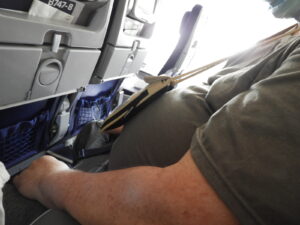 Rick and I just stared at each other, as the plane continued to fill. He did have foot room, but barely room to squeeze his elbows between the arm rests. And NO belly room! This was to be our world for the next 8 hours. We shuddered, and gritted our teeth.
Rick and I just stared at each other, as the plane continued to fill. He did have foot room, but barely room to squeeze his elbows between the arm rests. And NO belly room! This was to be our world for the next 8 hours. We shuddered, and gritted our teeth.
At least we had a screen, with games to play and movies to watch. However, we were instructed to wear our MASKS for the entire flight. I put myself into ENDURANCE MODE, playing the same Trivia Game answering the same Trivia Questions, over and over. I memorized ALL the answers. (Yes, the Orinoco River is in Venezuela.) No more contact with our attendants except during what was called “The Dinner Hour.” I had let my mask slide off one ear by then. “PUT ON YOUR MASK!” the attendant shouted, withholding my COLD FOOD package until I did.
And yet, we made it to Frankfurt. Daylight Friday morning in Germany. There was one wheelchair waiting outside the door of the plane. I inquired about the requested assistance for two. A tall, pale woman in uniform said, “I’ll take to you it.” She PUSHED the single wheelchair up the ramp, instructing me to walk behind her. I said, “If you are going to push the wheelchair, may I sit down in it?” “Just WAIT,” was her answer. Eventually we reached an elevator, and went up a floor. “You don’t have to walk much farther,” she said, holding tight to the empty wheel chair. We reached the main hallway and she directed us to a waiting area. “Sit there,” she said. “We don’t do wheelchairs.” And she pushed the empty wheelchair away.
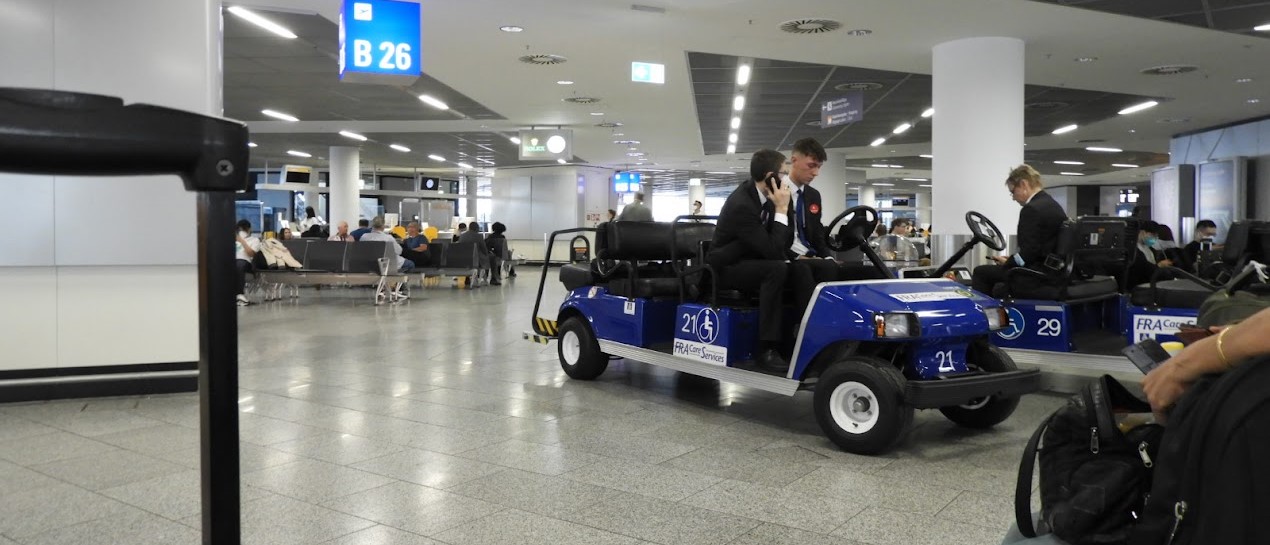 Two young men driving a cart approached, spiffy in black suits, skinny ties, short haircuts. “We’ll drive you to the bus,” was their instruction. Several more cart switches, drivers, transfers to a bus, a long drive to a different area, listening to employees discussing with each other the atrocities of work. Bragging about the efficiency of Frankfurt’s airport over anything else in Europe.
Two young men driving a cart approached, spiffy in black suits, skinny ties, short haircuts. “We’ll drive you to the bus,” was their instruction. Several more cart switches, drivers, transfers to a bus, a long drive to a different area, listening to employees discussing with each other the atrocities of work. Bragging about the efficiency of Frankfurt’s airport over anything else in Europe.
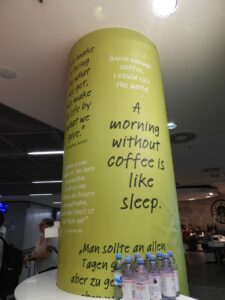 We were finally deposited at the gate for our Nairobi flight. We were starving! We took turns watching our luggage as we found restrooms. Then we began looking for food, or at least, COFFEE. One small shop, near. At least fifty people in line. A barista. Rows of coolers with drinks and sandwiches.
We were finally deposited at the gate for our Nairobi flight. We were starving! We took turns watching our luggage as we found restrooms. Then we began looking for food, or at least, COFFEE. One small shop, near. At least fifty people in line. A barista. Rows of coolers with drinks and sandwiches.
I approached the barista. “Is the line for all purchases, or is it the coffee line?” was my question. “The line is the line,” was the answer. “Now, go get in it, lady!”
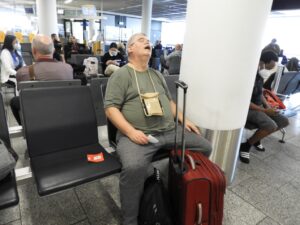 “I just need a cup of water,” I said. She handed me an empty cup and pointed. “There’s a fountain over THERE.”
“I just need a cup of water,” I said. She handed me an empty cup and pointed. “There’s a fountain over THERE.”
I found the fountain. I got some lukewarm water. I took my morning meds. Rick and I agreed – we’ll never fly Lufthansa again.
Of course, we had to. We had another 8 hours of Lufthansa from Frankfurt to Nairobi! Once again, we had middle-of-the-middle seats. Once again, we had crappy food. I did have room to put my feet, and our screens were better for gaming and for watching our progress as we flew south over the vast continent of Africa.
And then we landed in Nairobi, 70 miles SOUTH of the Equator. Our Wheelchair Assistants were there! “We have TRANSPORT to our hotel,” I told our Assistants. “Globus Tours.” We were rapidly wheeled through all the customs and security areas, how could there be so many SMILES? Smiles everywhere! Excitement! Welcome to Kenya! Welcome! Welcome!
The outside door of Jomo Kenyatta Airport! Hundreds of SIGNS waving. We finally spotted OUR transport vehicle, our driver.
 “My name is Douglas!” he said, in greeting. “Jambo! Welcome to Kenya!” He instructed our Assistants as to where to push our wheelchairs. He pulled his van to that spot. He helped us in, made sure our luggage was loaded. We told our Assistants goodbye, (large tip to each). Our energy level popped up about 50 percent, even though 30 hours had passed since we started at Clinton National. We were finally here!
“My name is Douglas!” he said, in greeting. “Jambo! Welcome to Kenya!” He instructed our Assistants as to where to push our wheelchairs. He pulled his van to that spot. He helped us in, made sure our luggage was loaded. We told our Assistants goodbye, (large tip to each). Our energy level popped up about 50 percent, even though 30 hours had passed since we started at Clinton National. We were finally here!
It was a 30-minute drive to Nairobi Serena Hotel. It was 10 PM, dark. Strange territory. But Douglas was all lightness, and cheer. “There are THREE WORDS you MUST know in Kenya!” he told us. “Jambo is the most important. It means HELLO!” He made us say it, back and forth. “The next most important is Asante, which is THANK YOU! And last, Karibu which means WELCOME. You can use it to welcome someone, as I welcome YOU, or, to say You are welcome, if someone has thanked you with Asante.”
We practiced, as we rode along. Douglas pointed out the sights. “Nairobi has a NATIONAL PARK within the city limits,” he said. “That is part of it to your left. Look for zebras! They are easy to spot at night.” We looked, but saw only darkness under the trees. Still, good to know. Douglas told us about the 42 tribes in Kenya. “I am Kikuyu,” he said, and our new PRESIDENT is Kikuyu. He will be inaugurated Tuesday! We are so happy to have one of ours in office now. I have SUCH HOPE for our country!” He went on to tell about the scarcity of jobs in Kenya, and how the new President is promising to increase opportunities for Kenyans.
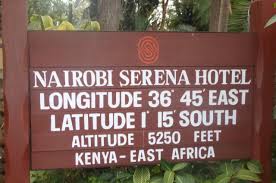 And then, we pulled into the driveway of Nairobi Serena Hotel. Douglas gave the necessary paperwork to the guard, the gate opened, we pulled to the entry. A doorman in a gold-trimmed white uniform opened the door of our van.
And then, we pulled into the driveway of Nairobi Serena Hotel. Douglas gave the necessary paperwork to the guard, the gate opened, we pulled to the entry. A doorman in a gold-trimmed white uniform opened the door of our van.
“Jambo!” he said. “Karibu!”
I felt right at home.
“I have an idea for my first post,” I said to Rick, as we rested in the lobby while Douglas got us checked in. “I’m going to name it Attitude at Latitude.”
FYI Airports
- Clinton National Airport, Little Rock: https://www.clintonairport.com/, serves abt 2 million passengers annually
- O’Hare International Airport, Chicago: https://www.flychicago.com/ohare/home/pages/default.aspx serves abt 54 million passengers annually
- Frankfurt Airport, Germany: https://www.frankfurt-airport.com/de.html serves abt 25 million passengers annually
- Jomo Kenyatta International Airport, Nairobi, Kenya: https://www.nairobi-airport.com/ serves abt 7 million passengers annually
» posted on Wednesday, September 7th, 2022 by Linda Lou Burton
Keeping In Touch
Linda Lou Burton posting from Little Rock, Arkansas – The days of waiting months for the slow boat to round the Horn with the mail are gone. We have cell phones now, so the main obstacle to communicating with someone on another continent is the time difference.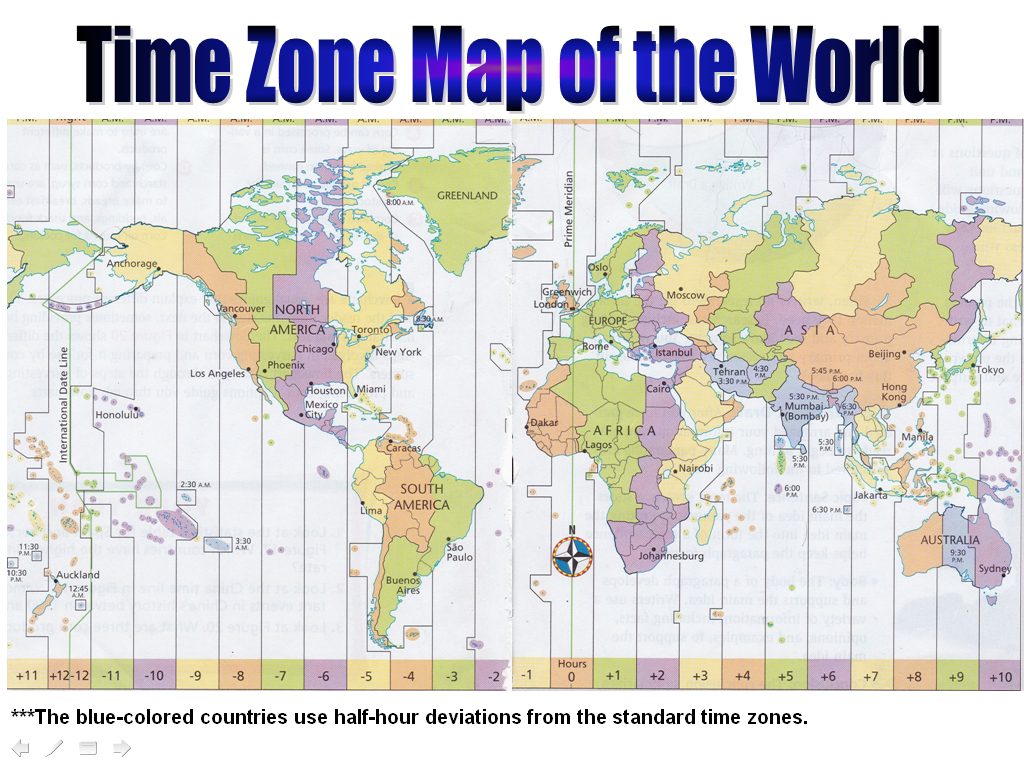
There are Time Converter websites, and Time Clock apps, if you can’t do the math about the GMT + or -. No point in calling someone in the middle of their sleepy time. So know that first. I live in Arkansas, smack in the Central Time Zone along with Chicago, and Houston. When we get to Kenya, and Tanzania, we’ll be on the same time as Moscow, and Madagascar. In Frankfurt, and Zurich, where we change planes, we’ll be in sync with Rome, and when in Iceland, well, it’s all too confusing, the way the powers-that-be have set it up with those crooked lines. Just Google it.
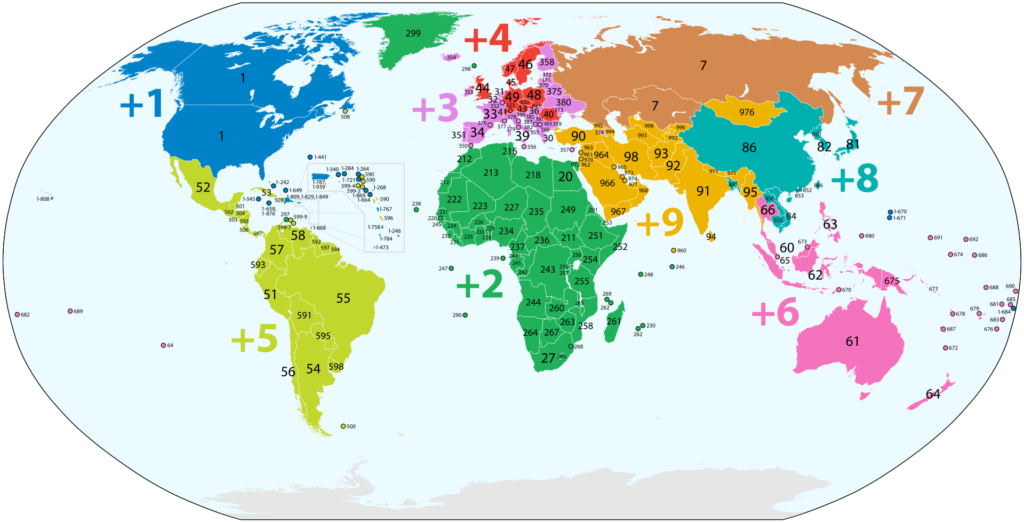 And then there’s the matter of Country Calling Codes. Yes, there is an International Telecommunication Union (the ITU) and member countries are assigned their own special number. The USA is #1. Remember that. Kenya is 254, Tanzania is 255, and Iceland is 354. You have to get through to the country before dialing the number of the place within the country. But oh, you have to dial OUT of the country you’re in before you can even do that. That number is 011. So, calling from the US to our hotel in Nairobi is 011-254-732124000. Or let your Android app figure it out.
And then there’s the matter of Country Calling Codes. Yes, there is an International Telecommunication Union (the ITU) and member countries are assigned their own special number. The USA is #1. Remember that. Kenya is 254, Tanzania is 255, and Iceland is 354. You have to get through to the country before dialing the number of the place within the country. But oh, you have to dial OUT of the country you’re in before you can even do that. That number is 011. So, calling from the US to our hotel in Nairobi is 011-254-732124000. Or let your Android app figure it out.
Lastly, it’s wise to know how to contact the U S Embassy in other countries, in case of some horrid disaster or unpredictable event when you can’t get through to us at all. Like maybe another volcano erupting in Iceland, only this time really HUGE, like the Mt St Helen’s blow-up in 1980 just as we were moving to Seattle.
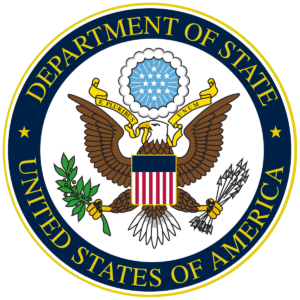 The US Department of State likes to look after its citizens when they travel; we’re registered with our Embassy in each of the three countries we’re visiting – they know when to expect us, are available to help us with any difficulties we may experience while there, and know how to get in touch with our family should the need arise.
The US Department of State likes to look after its citizens when they travel; we’re registered with our Embassy in each of the three countries we’re visiting – they know when to expect us, are available to help us with any difficulties we may experience while there, and know how to get in touch with our family should the need arise.
- KENYA: U.S. Embassy Nairobi, United Nations Avenue Nairobi, P. O. Box 606 Village Market, 00621 Nairobi, Kenya, 254 20 363-6000
- TANZANIA: U.S. Embassy in Dar es Salaam, 686 Old Bagamoyo Road, Msasani, Dar es Salaam, Tanzania, 255-22-229-4000
- ICELAND: U.S. Embassy in Reykjavik, Laufásvegur 21, 101 Reykjavík, 354 595 2200.
There you have it, we’re only a phone call away. Just don’t wake me up, please.
» posted on Monday, September 5th, 2022 by Linda Lou Burton
Warm Puppies
 Charles Schulz, who had a knack for explaining the obvious, once wrote a book about happiness. Remember Happiness is a Warm Puppy? It doesn’t take more description than that to know what he’s talking about! Just saying those words makes you feel happy, unless you’re really allergic to dogs, or once was terrorized by a German shepherd.
Charles Schulz, who had a knack for explaining the obvious, once wrote a book about happiness. Remember Happiness is a Warm Puppy? It doesn’t take more description than that to know what he’s talking about! Just saying those words makes you feel happy, unless you’re really allergic to dogs, or once was terrorized by a German shepherd.
For the last ten years, statistical PROOF of happiness has been the goal of a group of learned, detail-specific folks who have been asking questions and analyzing data in 150 countries. And producing The World Happiness Report, giving us a picture of our global joy, or unrest.
What exactly do they consider? Some basic things you’d expect based on where you live: life expectancy in your country, GDP per capital in terms of purchasing power, freedom to make choices about what you do with your life, perceptions of corruption in your government, and amount of social support. Personal attitudes and experiences come into play as well: did you do something yesterday that made you laugh? Did you do something interesting, or learn something new? Did you donate money to a charity? Do you have friends you can count on?
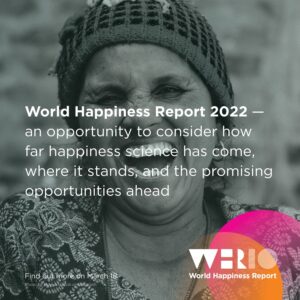 I won’t get into the statistical methods used, or the pages and pages (and pages) of data, but here’s a link to the entire project: https://worldhappiness.report/ and I encourage you to take a look. It’s fascinating! This year in particular, because they focused on the impact of COVID. With the world entering the third year of the pandemic, the report has three areas of focus in 2022: looking back; looking at how people and countries are doing in the face of COVID; and looking ahead to how the science of well-being is likely to evolve in the future.
I won’t get into the statistical methods used, or the pages and pages (and pages) of data, but here’s a link to the entire project: https://worldhappiness.report/ and I encourage you to take a look. It’s fascinating! This year in particular, because they focused on the impact of COVID. With the world entering the third year of the pandemic, the report has three areas of focus in 2022: looking back; looking at how people and countries are doing in the face of COVID; and looking ahead to how the science of well-being is likely to evolve in the future.
On the positive side, the most remarkable change was the global upsurge in benevolence in 2021. In every global region, there have been large increases in the proportion of people who give money to charity, help strangers, and do volunteer work. COVID also demonstrated the crucial importance of trust for human well-being. Deaths from COVID during 2020 and 2021 were markedly lower in those countries with higher trust in public institutions, and where inequality is lower.
The happiest countries in 2022? Finland, Denmark, Iceland, Switzerland, and the Netherlands make up the Top Five. The US came in at #16 – despite our low rankings in safety, we’re a country with a high life expectancy (78 for men, 83 for women), and despite our perceptions of too-low wages, a per capita GDP of over $62K. Much to be happy about!
Kenya and Tanzania ranked quite low according to those measures; life expectancy in both countries is in the low 60s for men and women; per capita GDP is just over $3,000, and about 30% of the population is considered undernourished. But in measures of attitude, the 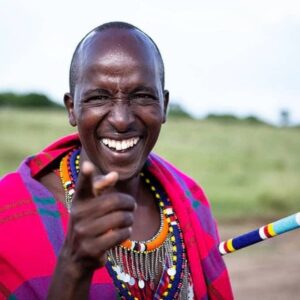 people of these countries are an example of the highest form of happiness – the ability to appreciate what they have. Kenyans are a gregarious, hospitable, easy-going, and intensely curious people. They take pleasure in meeting visitors and finding out about their way of life. Undungu, translated as “brotherhood,” conveys the spirit of Tanzanians; the idea of generosity, consideration, and compassion towards both family, and community. Any visitor to the country can expect to hear the Swahili word Karibu frequently. It means “welcome.”
people of these countries are an example of the highest form of happiness – the ability to appreciate what they have. Kenyans are a gregarious, hospitable, easy-going, and intensely curious people. They take pleasure in meeting visitors and finding out about their way of life. Undungu, translated as “brotherhood,” conveys the spirit of Tanzanians; the idea of generosity, consideration, and compassion towards both family, and community. Any visitor to the country can expect to hear the Swahili word Karibu frequently. It means “welcome.”
And that’s a warm puppy, for sure.
The World Happiness Report is a publication of the Sustainable Development Solutions Network, powered by the Gallup World Poll data.



